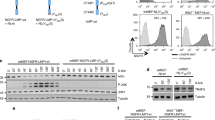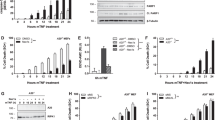Abstract
Nuclear factor-κB essential modulator (NEMO), also called IKKγ, has been proposed as a ‘universal’ adaptor of the I-κB kinase (IKK) complex for stimuli such as proinflammatory cytokines, microbes, and the HTLV-I Tax oncoprotein. Currently, it remains unclear whether the many signals that activate NF-κB through NEMO converge identically or differently. We have adopted two approaches to answer this question. First, we generated and targeted intracellularly three NEMO-specific monoclonal antibodies (mAbs). These mAbs produced two distinct intracellular NF-κB inhibition profiles segregating TNFα from Tax activation. Second, using NEMO knockout mouse fibroblasts and 10 NEMO mutants, we found that different regions function in trans either to complement or to inhibit dominantly TNFα, IL-1β, or Tax activation of NF-κB. For instance, NEMO (1—245 amino acids) supported Tax-mediated NF-κB activation, but did not serve TNFα- or IL-1β signaling. Altogether, our findings indicate that while NEMO ‘universally’ adapts numerous NF-κB activators, it may do so through separable domains. We provide the first evidence that selective targeting of NEMO can abrogate oncogenic Tax signaling without affecting signals used for normal cellular metabolism.
This is a preview of subscription content, access via your institution
Access options
Subscribe to this journal
Receive 50 print issues and online access
$259.00 per year
only $5.18 per issue
Buy this article
- Purchase on Springer Link
- Instant access to full article PDF
Prices may be subject to local taxes which are calculated during checkout








Similar content being viewed by others
References
Agou F, Ye F, Goffinont S, Courtois G, Yamaoka S, Israel A and Veron M . (2002). J. Biol. Chem., 277, 17464–17475.
Bai J, Sui J, Zhu RY, Tallarico AS, Gennari F, Zhang D and Marasco WA . (2003). J. Biol. Chem., 278, 1433–1442.
Ballard DW, Bohnlein E, Lowenthal JW, Wano, Franza BR and Greene WC . (1988). Science, 241, 1652–1655.
Beyaert R, Heyninck K and Van Huffel S . (2000). Biochem. Pharmacol., 15, 1143–1151.
Chen ZJ, Parent L and Maniatis T . (1996). Cell, 84, 853–862.
Chu ZL, Shin YA, Yang JM, DiDonato JA and Ballard DW . (1999). J. Biol. Chem., 274, 15297–15300.
Courtois G, Smahi A and Israel A . (2001). Trends Mol. Med., 7, 427–430.
Courtois G, Whiteside ST, Sibley CH and Israel A . (1997). Mol. Cell. Biol., 17, 1441–1449.
DiDonato JA, Hayakawa M, Rothwarf DM, Zandi E and Karin M . (1997). Nature, 388, 548–554.
Ghosh S, Goldin E, Gordon FH, Malchow HA, Rask-Madsen J, Rutgeerts P, Vyhnalek P, Zadorova Z, Palmer T, Donoghue S and Natalizumab Pan-European Study Group. (2003). N. Engl. J. Med., 348, 24–32.
Grassmann R, Dengler C, Muller-Fleckenstein I, McGuire K, Dokhelar MC, Sodroski JG and Haseltine WA . (1989). Proc. Natl. Acad. Sci. USA, 86, 3351–3355.
Harhaj EW and Sun SC . (1999). J. Biol. Chem., 274, 22911–22914.
Hinuma Y, Nagata K, Hanaoka M, Nakai M, Matsumoto T, Kinoshita KI, Shirakawa S and Miyoshi I . (1981). Proc. Natl. Acad. Sci. USA, 78, 6476–6480.
Hu Y, Baud V, Delhase M, Zhang P, Deerinck T, Ellisman M, Johnson R and Karin M . (1999). Science, 284, 316–320.
Huang GJ, Zhang ZQ and Jin DY . (2002). FEBS Lett., 531, 494–498.
Iha H, Kasai T, Kibler KV, Iwanaga Y, Tsurugi K and Jeang KT . (2000). AIDS Res. Hum. Retroviruses, 16, 1633–1638.
Iwanaga Y, Kasai T, Kibler K and Jeang KT . (2002). J. Biol. Chem., 277, 31005–31012.
Jain A, Ma CA, Liu S, Brown M, Cohen J and Strober W . (2001). Nat. Immunol., 2, 223–228.
Jin DY, Giordano V, Kibler KV, Nakano H and Jeang KT . (1999). J. Biol. Chem., 274, 17402–17405.
Karin M . (1999). J. Biol. Chem., 274, 27339–27342.
Karin M, Cao Y, Greten FR and Li ZW . (2002). Nat. Rev. Cancer, 2, 301–310.
Karin M and Lin A . (2002). Nat. Immunol., 3, 221–227.
Kasai T, Iwanaga Y, Iha H and Jeang KT . (2002). J. Biol. Chem., 277, 5187–5193.
Kibler KV and Jeang K-T . (2001). J. Virol., 75, 2161–2173.
Kitajima I, Shinohara T, Bilakovics J, Brown DA, Xu X and Nerenberg M . (1992). Science, 258, 1792–1795.
Li Q, Lu Q, Hwang JY, Buscher D, Lee KF, Izpisua-Belmonte JC and Verma IM . (1999a). Genes Dev., 13, 1322–1328.
Li Q, Van-Antwerp D, Mercurio F, Lee KF and Verma IM . (1999b). Science, 284, 321–325.
Li Q and Verma IM . (2002). Nat. Rev. Immunol., 2, 725–734.
Li XH, Fang X and Gaynor RB . (2001). J. Biol. Chem., 276, 4494–4500.
Li Y, Kang J, Friedman J, Tarassishin L, Ye J, Kovalenko A, Wallach D and Horwitz MS . (1999c). Proc. Natl. Acad. Sci. USA, 96, 1042–1047.
Li ZW, Chu W, Hu Y, Delhase M, Deerinck T, Ellisman M, Johnson R and Karin M . (1999d). J. Exp. Med., 189, 1839–1845.
Lupas A, Van Dyke M and Stock J . (1991). Science, 252, 1162–1164.
Makris C, Godfrey VL, Krahn-Senftleben G, Takahashi T, Roberts JL, Schwarz T, Feng L, Johnson RS and Karin M . (2000). Mol. Cell, 5, 969–979.
Marriott SJ, Lemoine FJ and Jeang KT . (2002). J. Biomed. Sci., 9, 292–298.
May MJ, D’Acquisto F, Madge LA, Glockner J, Pober JS and Ghosh S . (2000). Science, 289, 1550–1554.
Mercurio F, Murray BW, Shevchenko A, Bennett BL, Young DB, Li JW, Pascual G, Motiwala A, Zhu H, Mann M and Manning AM . (1999). Mol. Cell. Biol., 19, 1526–1538.
Mercurio F, Zhu H, Murray BW, Shevchenko A, Bennett BL, Li J, Young DB, Barbosa M, Mann M and Rao A . (1997). Science, 278, 860–866.
Miller BS and Zandi E . (2001). J. Biol. Chem., 276, 36320–36326.
Mori N, Shirakawa F, Shimizu H, Murakami S, Oda S, Yamamoto K and Eto S . (1994). Blood, 84, 2904–2911.
Nerenberg M, Hinrichs SH, Reynolds RK, Khoury G and Jay G . (1987). Science, 237, 1324–1329.
Ng PW, Iha H, Iwanaga Y, Bittner M, Chen Y, Jiang Y, Gooden G, Trent JM, Meltzer P, Jeang KT and Zeichner SL . (2001). Oncogene, 27, 4484–4496.
Orlowski RZ and Baldwin Jr AS . (2002). Trends Mol. Med., 8, 385–389.
Poyet JL, Srinivasula SM, Lin JH, Fernandes-Alnemri TF, Yamaoka S, Tasichlis PN and Alnemri ES . (2000). J. Biol. Chem., 275, 37966–37977.
Prajapati S and Gaynor RB . (2002). J. Biol. Chem., 277, 24331–24339.
Ranson M and Sliwkowski MX . (2002). Oncology, 63, 17–24.
Robek MD and Ratner L . (1999). J. Virol., 73, 4856–4865.
Rothwarf DM and Karin M . (1999). Sci. STKE, 26, RE1.
Rothwarf DM, Zandi E, Natoli G and Karin M . (1998). Nature, 395, 297–300.
Rudolph D, Yeh WC, Wakeham A, Rudolph B, Nallainathan D, Potter J, Elia AJ and Mak TW . (2000). Genes Dev., 14, 854–862.
Scheidereit C . (1998). Nature, 395, 225–226.
Schmidt-Supprian M, Bloch W, Courtois G, Addicks K, Israel A, Rajewsky K and Pasparakis M . (2000). Mol. Cell, 5, 981–992.
Takeda K, Takeuchi O, Tsujimura T, Itami S, Dachi O, Kawai T, Sanjo H, Yoshikawa K, Terada N and Akira S . (1999). Science, 284, 313–316.
Tanaka A, Takahashi C, Yamaoka S, Nosaka T, Maki M and Hatanaka M . (1990). Proc. Natl. Acad. Sci. USA, 87, 1071–1075.
Tanaka M, Fuentes ME, Yamaguchi K, Durnin MH, Dalrymple SA, Hardy KL and Goeddel DV . (1999). Immunity, 10, 421–429.
Tarassishin L and Horwitz MS . (2001). Biochem. Biophys. Res. Commun., 285, 555–560.
Tegethoff S, Behlke J and Scheidereit C . (2003). Mol. Cell. Biol., 23, 2029–2041.
Tsukahara T, Kannagi M, Ohashi T, Kato H, Arai M, Nunez G, Iwanaga Y, Yamamoto N, Ohtani K and Fujii M . (1999). J. Virol., 73, 7981–7987.
Whiteside ST and Israel A . (1997). Semin. Cancer Biol., 8, 75–82.
Xiao G, Harhaj EW and Sun SC . (2000). J. Biol. Chem., 275, 34060–34067.
Yamamoto Y and Gaynor RB . (2001). J. Clin. Invest., 107, 135–142.
Yamamoto Y, Kim DW, Kwak YT, Prajapati S, Verma U and Gaynor RB . (2001). J. Biol. Chem., 276, 36327–36336.
Yamaoka S, Courtois G, Bessia C, Whiteside ST, Weil R, Agou F, Kirk HE, Kay RJ and Israel A . (1998). Cell, 93, 1231–1240.
Ye J, Xie X, Tarassishin L and Horwitz MS . (2000). J. Biol. Chem., 275, 9882–9889.
Yoshida M . (2001). Annu. Rev. Immunol., 19, 475–496.
Yoshida M, Miyoshi I and Hinuma Y . (1982). Proc. Natl. Acad. Sci. USA, 79, 2031–2035.
Zandi E, Rothwarf DM, Delhase M, Hayakawa M and Karin M . (1997). Cell, 91, 243–252.
Zhang SQ, Kovalenko A, Cantarella G and Wallach D . (2000). Immunity, 12, 301–311.
Acknowledgements
We are indebted to Marc Schmidt-Supprian for NEMO knockout cells. We thank Shao-Cong Sun for plasmids, Alicia Buckler-White for sequencing, George Dapolito for technical assistance, and Dong-Yan Jin for reading the manuscript.
Author information
Authors and Affiliations
Corresponding author
Rights and permissions
About this article
Cite this article
Iha, H., Kibler, K., Yedavalli, V. et al. Segregation of NF-κB activation through NEMO/IKKγ by Tax and TNFα: implications for stimulus-specific interruption of oncogenic signaling. Oncogene 22, 8912–8923 (2003). https://doi.org/10.1038/sj.onc.1207058
Received:
Revised:
Accepted:
Published:
Issue Date:
DOI: https://doi.org/10.1038/sj.onc.1207058
Keywords
This article is cited by
-
DNA-PK: gatekeeper for IKKγ/NEMO nucleocytoplasmic shuttling in genotoxic stress-induced NF-kappaB activation
Cellular and Molecular Life Sciences (2020)
-
Oral administration of an HSP90 inhibitor, 17-DMAG, intervenes tumor-cell infiltration into multiple organs and improves survival period for ATL model mice
Blood Cancer Journal (2013)
-
Wip1 and p53 contribute to HTLV-1 Tax-induced tumorigenesis
Retrovirology (2012)
-
Antitumor activity and macrophage nitric oxide producing action of medicinal herb, Crassocephalum crepidioides
BMC Complementary and Alternative Medicine (2012)
-
Human T-cell leukemia virus type 1 (HTLV-1) and leukemic transformation: viral infectivity, Tax, HBZ and therapy
Oncogene (2011)



